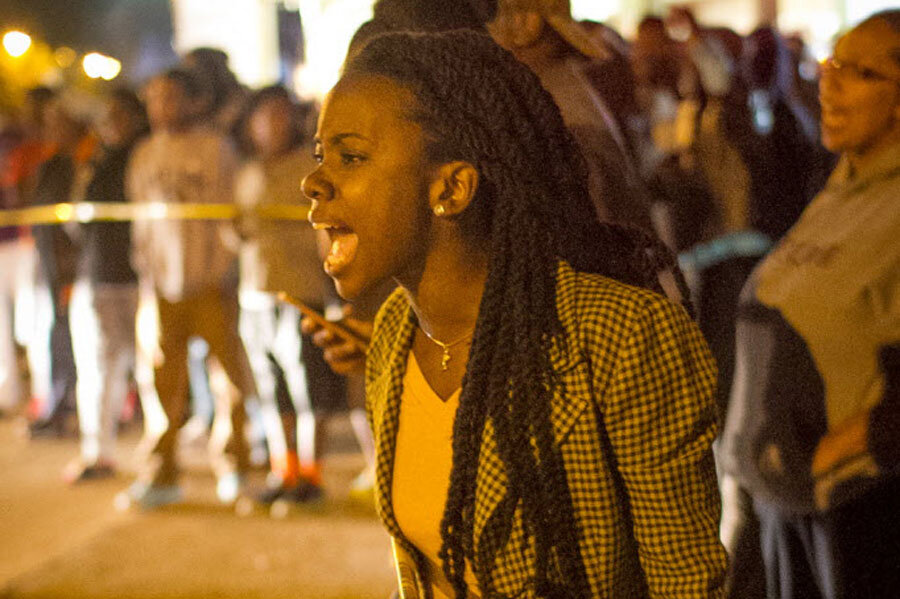Tensions flare in St. Louis after off-duty cop shoots teenager
Loading...
Angry protests spilled out of Ferguson, Mo., and into greater St. Louis Wednesday night after a white off-duty police officer chased and shot a black high school student named Vonderrit Myers, Jr., whom police allege fired at the officer first.
The shooting in the Shaw neighborhood of St. Louis, a dozen miles south of Ferguson, is likely to only exacerbate a very rough stretch for greater St. Louis, an aging river city struggling to reckon with a deep legacy of racial segregation and oppression.
Until Wednesday night, that struggle has been mostly on display in Ferguson, Mo. The Aug. 9 shooting of teenager Michael Brown by a white police officer brought long-simmering tensions over discriminatory policing to a boil. Protests got so out of control in the aftermath that Gov. Jay Nixon (D) had to call in the National Guard.
Last night, 17 shots were fired by the unnamed police officer who killed Vonderrit in the Shaw community of St. Louis, a leafy and relatively crime-free corner of the city.
Police did not release the teen’s name, but family members identified him to the press. Police did rush to provide other details. Since Mr. Brown’s shooting, it’s become more common for police departments to provide more transparency in the wake of shootings.
Despite that, several hundred people gathered, at one point shouting, “[expletive] the police” and "hands up, don't shoot" and banging on police cars.
One witness said gunshots rang out near the protests Wednesday night, but police did not curtail the protests nor don riot gear.
There were no arrests, and St. Louis Police Chief Sam Dotson says officers “acted with great restraint” in the face of the angry crowd.
The 18-year-old's family says Vonderrit was carrying a sandwich, not a gun.
Police say the officer was in his city police uniform but working as a private security detail when he confronted three males who ran when he drove by. The officer gave chase and caught Vonderrit, resulting in a “physical altercation” where the officer pulled off the teen’s gray-hooded sweater.
The officer said the teenager grabbed at his waist as he escaped, which suggested he had a gun. The officer, however, did not open fire “because he wanted to be certain it was a gun,” Chief Dotson said.
The teenager then opened fire on the officer, getting off three shots before his gun jammed, according to Dotson. The officer’s return fire killed the teen, whom police say had had previous run-ins with the law.
Distrust between police and the city’s black population has bristled since the Brown shooting, exploding at times into raucous protests involving both locals and anti-police brutality activists from out of town.
A grand jury is expected to indicate next month whether or not it will indict Ferguson Police Officer Darren Wilson, whom witnesses say shot and killed Brown after the teenager raised his hands in surrender. City officials are bracing for mayhem should Wilson not be indicted.
Wilson’s supporters believe the evidence will show that Brown, whom police say had punched Wilson and had reached for his gun, had turned to rush the smaller police officer when he was struck by a volley of six shots.
Late last month, the US Department of Justice urged Ferguson Police Chief Tom Jackson to tell his officers to stop wearing “I Am Darren Wilson” armbands in solidarity with the officer who killed Brown.
The armbands, wrote Christy Lopez, a deputy chief in the Civil Rights Division, “reinforce the very ‘us versus them’ mentality that many residents of Ferguson believe exists.”
The sudden eruption of black anger has disquieted a city where many white residents have expressed surprise that black people were feeling so slighted. The palpable racial tension interrupted even a St. Louis Cardinals baseball game on Tuesday, where largely white fans exchanged racially charged words with black protesters outside Busch Stadium.
“If you all were working, we wouldn’t have this problem,” one white fan told the protesters, who have begun to picket local events.
The Shaw shooting was the third time white police officers gunned down black men in the street in the past two months.
Several days after the Brown shooting, St. Louis police officers shot and killed a mentally disturbed man who refused orders to drop a knife. That shooting was caught on video, which showed no hesitation by officers to fire on the man as he approached them.






